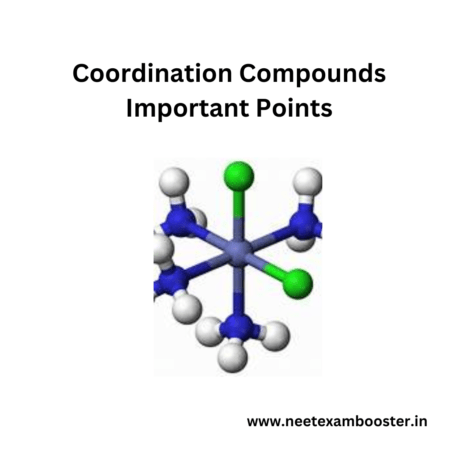Coordination compounds important points – Coordination compounds are the compounds consisting of a central metal ion or atom surrounded by ligands. They exhibits various types of isomerism, including the structural and the stereoisomerism. Ligands can be classified based on their ability to donate to the electron pairs, and chelation occurs when a ligand forms a multiple bonds with the same metal ion.
Transition metals are commonly found as the central metal ions due to their versatility in forming the complex structures. Coordination compounds have different applications in fields such as medicine, industry, and environmental chemistry. They can act as catalysts, have medicinal uses, and plays a vital role in environmental processes. The stability and reactivity of the coordination compounds are influenced by factors like pH, temperature, ligand and metal ion properties. They can undergo redox reactions and form complexes with the other coordination compounds.
Overall, coordination chemistry is a significant area of study that contributes to our understanding of bonding, reactivity, and design of materials with specific properties.
Coordination compounds important points, Coordination compounds important points, Coordination compounds important points, Coordination compounds important points, Coordination compounds important points

NCERT Chemistry Class 12 Chapter 9 – Coordination compounds 25 important points
There are 25 important points on coordination compounds-
- Coordination compounds are compounds composed of a central metal ion or atom surrounded by the ligands.
- Ligands are the molecules or ions that donate a pair of electrons to the metal ion, forming coordinate bonds.
- The coordination number is defined as the number of ligands bonded to the central metal ion.
- The coordination sphere refers to central metal ion and its coordinated ligands.
- Isomerism is common in coordination compounds, including the structural isomerism and the stereoisomerism.
- Structural isomerism in coordination compounds occurs when connectivity of atoms between the ligands and the central metal ion differs.
- Stereoisomerism in coordination compounds arises from different spatial arrangements of ligands around the central metal ion.
- Geometric isomerism is a type of stereoisomerism where ligands can be arranged in different geometries around the metal ion.
- Optical isomerism is a type of stereoisomerism where ligands are arranged in a way that the compound is not superimposable on its mirror image.
- Chelation occurs when a ligand forms multiple coordinate bonds with same central metal ion, resulting in a chelate complex.
- Ligands can be classified as the monodentate (donate one electron pair), bidentate (donate two electron pairs), or polydentate (donate multiple electron pairs).
- Coordination compounds often exhibits a variety of colors due to absorption of specific wavelengths of light by the metal-ligand complexes.
- Transition metals are commonly found as the central metal ions in coordination compounds due to their ability to form multiple oxidation states and complex structures.
- The coordination chemistry of transition metals plays a crucial role in the biological systems, such as metalloproteins and enzymes.
- Coordination compounds can exhibits paramagnetic or diamagnetic properties depending on presence of unpaired electrons in the metal-ligand complex.
- Ligand field theory provides a framework for understanding electronic structure and properties of the coordination compounds based on the splitting of d orbitals in the presence of ligands.
- Crystal field theory is a simplified version of ligand field theory that considers only electrostatic interactions between the metal ion and ligands.
- Coordination compounds can act as catalysts in various chemical reactions, including the homogeneous and heterogeneous catalysis.
- Coordination compounds finds applications in the field of medicine, as anticancer drugs, contrast agents in medical imaging, and in the treatment of certain diseases.
- Coordination compounds are widely used in the industrial processes, such as metal extraction, electroplating, and catalytic converters in automobiles.
- Coordination compounds are involved in the environmental chemistry, including transport and transformation of metals in aquatic systems and the detoxification of heavy metals.
- The stability and reactivity of the coordination compounds can be influenced by factors such as pH, temperature, and the nature of the ligands and metal ion.
- Coordination compounds can undergo redox reactions, where the metal ion changes its oxidation state while ligands remain intact.
- Coordination compounds can form complexes with the other coordination compounds, leading to the formation of supramolecular architectures.
- Coordination chemistry is a vast field of study that continues to contribute to our understanding of chemical bonding, reactivity, and design of new materials with specific properties.
Some Important Questions From Biology Class 11
| Chapter Name | Quiz Link |
| The Living World | Play Now |
| Biological Classification | Play Now |
| Plant Kingdom | Play Now |
| Animal Kingdom | Play Now |
| Morphology of flowering plants | Play Now |
| Anatomy of flowering plants | Play Now |
| Cell: the unit of life | Play Now |
| Biomolecules | Play Now |
| Cell Cycle and cell division | Play Now |
| Transport in Plants | Play Now |
| Structural organisation in Animals | Play Now |
| Mineral nutrition | Play Now |
| Photosynthesis in higher plants | Play Now |
| Respiration in plants | Play Now |
| Plant Growth and development | Play Now |
| Digestion and Absorption | Play Now |
| Breathing and Exchange of Gases | Play Now |
| Body fluids and circulation | Play Now |
| Excretory products and their elimination | Play Now |
| Locomotion and Movement | Play Now |
| Neural Control and Coordination | Play Now |
| Chemical Coordination and Integration | Play Now |
Some Important Questions From Biology Class 12
| Chapter Name | Quiz Link |
| Reproduction in organism | Play Now |
| Sexual reproduction in flowering plant | Play Now |
| Human reproduction | Play Now |
| Reproductive health | Play Now |
| Principles of inheritance and variation | Play Now |
| Molecular basis of inheritance | Play Now |
| Evolution | Play Now |
| Human health and disease | Play Now |
| Strategies for enhancement in food product | Play Now |
| Microbes in human welfare | Play Now |
| Biotechnology principles and processes | Play Now |
| Biotechnology and its application | Play Now |
| Organism and population | Play Now |
| Ecosystem | Play Now |
| Biodiversity and its conservation | Play Now |
| Environment issue | Play Now |





 155 out of 200 questions were directly asked from these notes in NEET 2024
155 out of 200 questions were directly asked from these notes in NEET 2024
